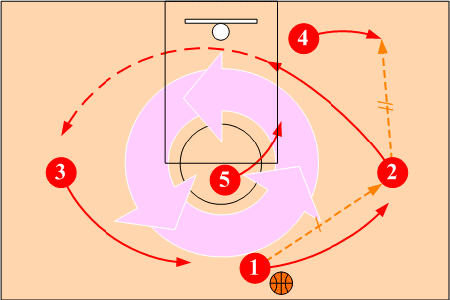Basketball Tips & Strategies – November 2009
HoopTactics What’s New
Player Development: Improving Free Throw Accuracy, Free Throw Marksman Club, Defending Against Dribble Penetration,
Defensive Strategies: Techniques for Disrupting “Off Ball” Screens, Defensive Rebounding Principles and Techniques
Quick Tip: Individual Defensive Skills and Techniques
Like their offensive counterparts, defensive fundamentals must be broken down and practiced constantly on all levels of basketball. Players need to know and practice how to guard the player with the ball, how to guard a player without the ball, how to guard a cutter, how to guard a player in post area, and how to box out and rebound on shots.
Featured Play: Clock Zone Offense
The “Clock” is a very simple but powerful zone offense. It is easy to teach, learn and execute. It incorporates a basic 1-3-1 free lance passing attack with a few basic rotation rules. It gets its name from the outside players clockwise and counter clockwise rotations. The Clock Offense is ideal for those looking for a very effective, but simple zone offense. Learn More – Click Here
Coaching Tips: Importance of Player Development
Individual player development, on and off the court, is the greatest satisfaction of coaching. Basketball is unique in that it is a game within a game. However, we coaches often have a tendency to spend more time on introducing and refining plays or defenses rather than developing and improving individual player skills and techniques that will ultimately determine their success or failure.
Remember, basketball is not a game of offenses and defenses, but a game of effort and execution. Coach your players, not the system. Be sure to develop all of your players to the best of their capabilities. Coaching great players is easy. Where great coaches excel is in getting the most out of every player on the squad regardless of physical abilities and skills.
GUIDANCE
“Regard your soldiers as your children, and they may follow you wherever you may lead.
Look upon them as your beloved sons, and they will stand by you even unto death.
If, however, you are indulgent, but unable to make your authority felt; kind hearted but unable to
enforce your commands; and incapable, moreover, of quelling disorder,
Then, your soldiers must be able to liken to spoiled children. They are useless for all tactical purposes.”
Sun Tzu Wu, Art of War 450 BC
Defending Against Out-Numbered Situations
Transition defense starts with being able to defend the out numbered situation. Players should be well schooled in how to defending out-numbered situations. Successfully defending an outnumbered break is a really big play (RBP). It often times makes the difference in winning or losing a close game.
Do not make the mistake of taking for granted that players are already knowledgeable and skilled in how to defend against the out number situations. Players need to be taught the correct way to “Wolf” (catch a dribbler from behind), how to defend 2 & 3 against one situations as well as 3 & 4 against two situations. To learn More – Premium Members Click Here
Defensive Rebounding a Total Team Effort
The importance of rebounding defensively cannot be over emphasized. A rebound on defense is equivalent to a made shot on offense. A team can play tremendous defense and force a bad or rushed shot, but this defensive effort will be wasted if the offense is allowed to rebound the missed shot. For any defensive effort to be successful it must end in a turnover or defensive rebound (defensive stop).
Defensive rebounding is a coordinated team effort, and every player must realize that it is just as important to box out and prevent their opponent from getting the rebound as it is to obtain the rebound. Therefore, defensive rebounding is one of those situations in basketball where it’s not the number of times you do, but it’s the time you do not that counts. This means that the defenders block every offensive player’s path to the basket and ball on every shot during a game. This is especially true for the shooter since they know where the ball is going as soon as it leaves their hand. Learn More – Premium Members Click Here
Posted: November 1st, 2009 under Coaching Strategies | Defensive Strategies | Offensive Strategies.
Tags: Attitude, Boxing Out, Clock Zone Offense, Coaching, Defense, Defensive Rebounds, Defensive Stops, Flight Time, Out Numbered Situation, Player, RBP (Really Big Play), Skills & Techniques, Teaching, Teamwork, Wolf, Zone Offense



